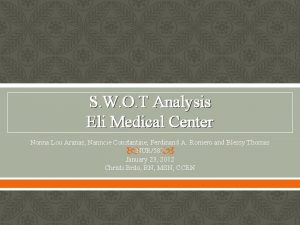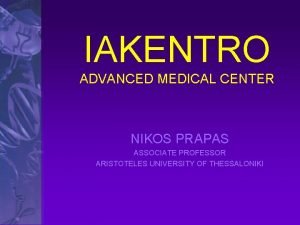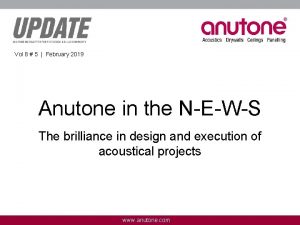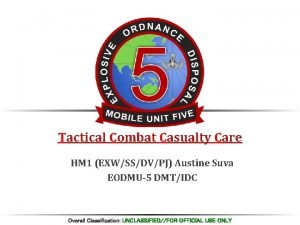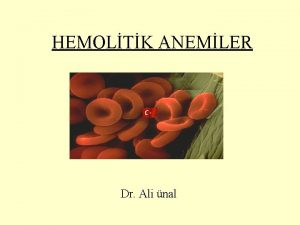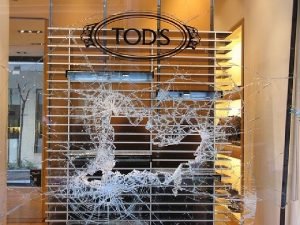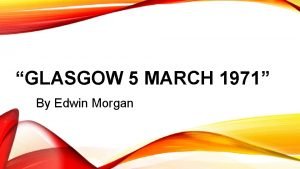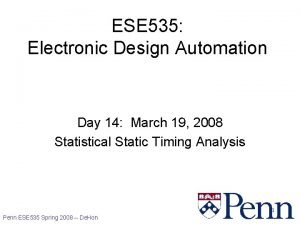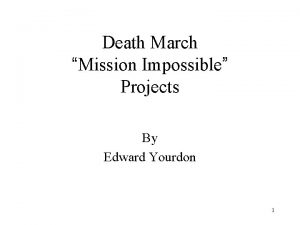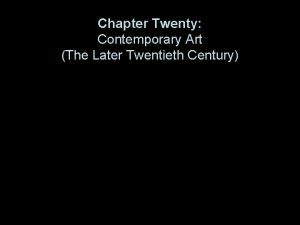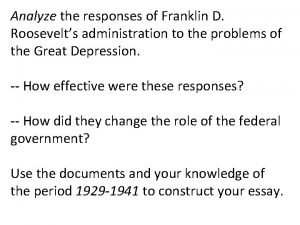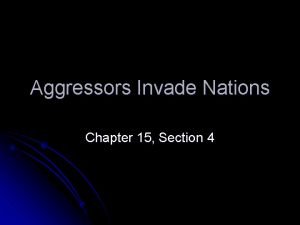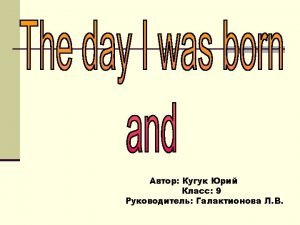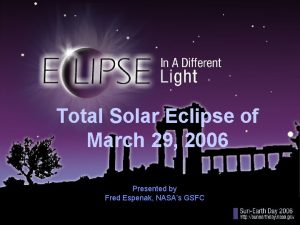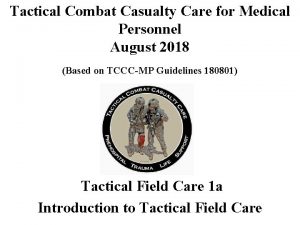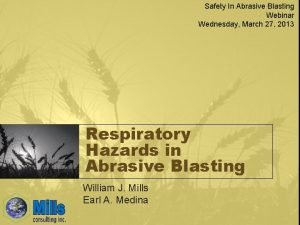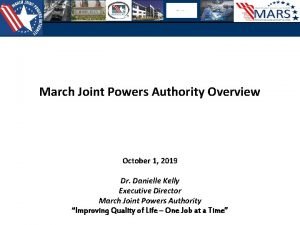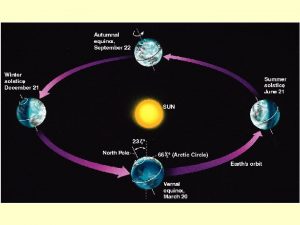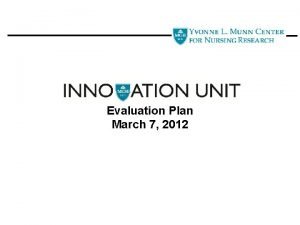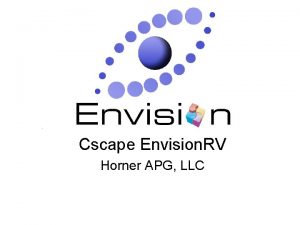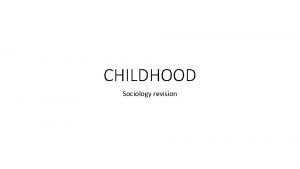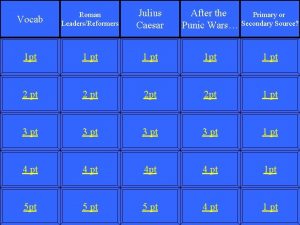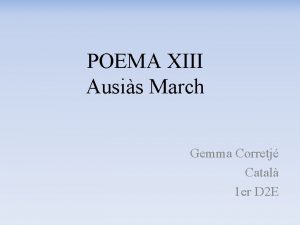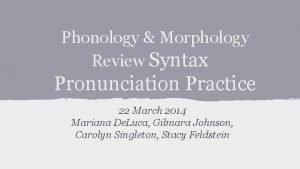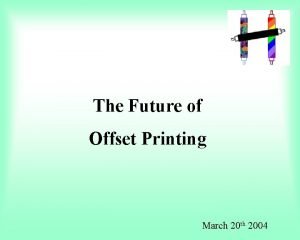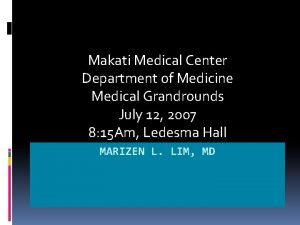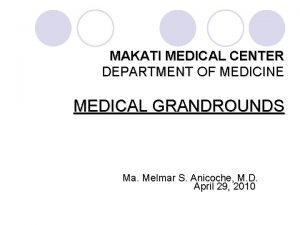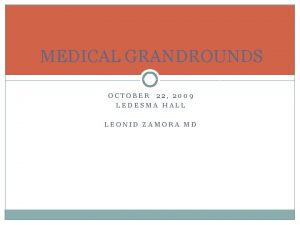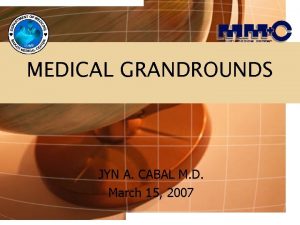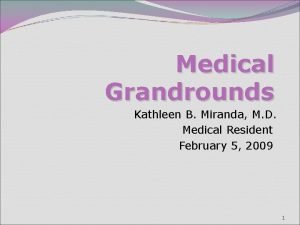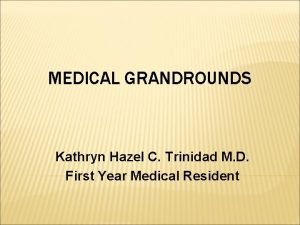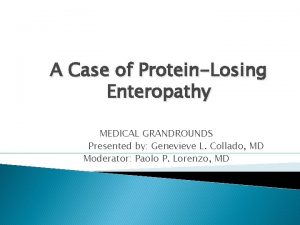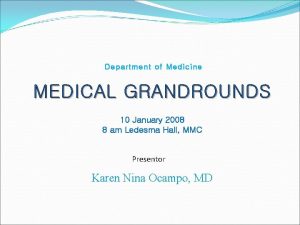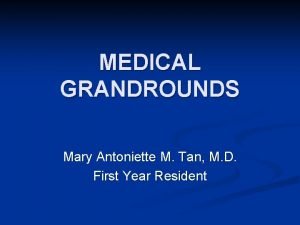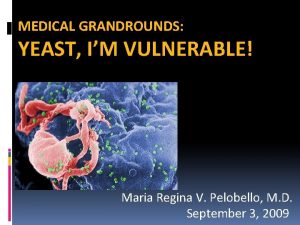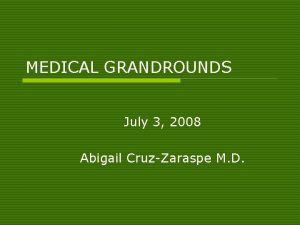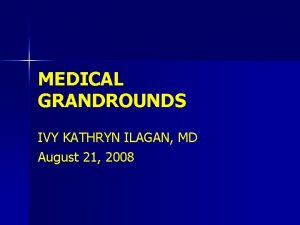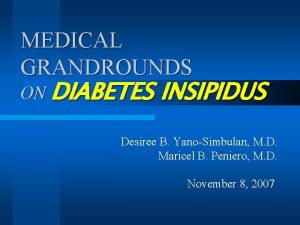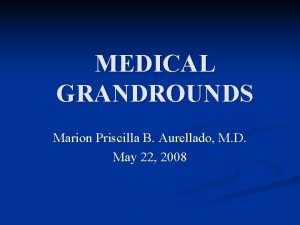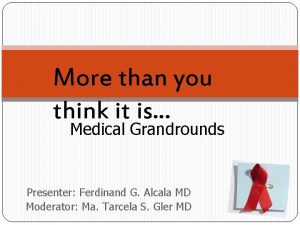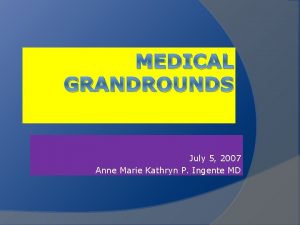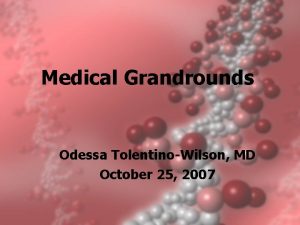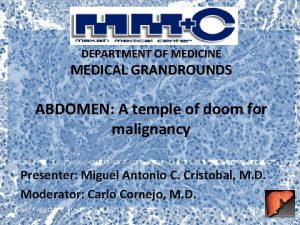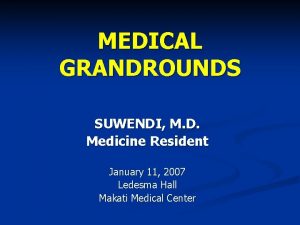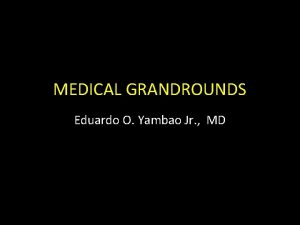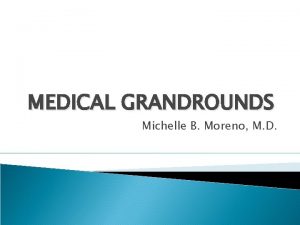MAKATI MEDICAL CENTER MEDICAL GRANDROUNDS MARCH 12 2009






























































- Slides: 62

MAKATI MEDICAL CENTER MEDICAL GRANDROUNDS MARCH 12, 2009 ESTHESIONEUROBLASTOMA and CUSHING’S SYNDROME ARIANNE SY-UMALI, MD PRESENTOR

OBJECTIVES n n n To discuss a case of Cushing’s syndrome 2 o to ectopic ACTH secretion 2 o to metastatic Esthesioneuroblastoma. Approach to diagnosis of a patient with Cushing’s syndrome. Management of a patient with ectopic ACTH secretion.

PATIENT DATA M. C. n 42 y/o n Female n

CHIEF COMPLAINT n Stiffening of extremities

HISTORY OF PRESENT ILLNESS 7 years PTA (2001) Dx: Esthesioneuroblastoma (olfactory neuroblastoma) S/p craniofacial resection with biopsy S/p cobalt therapy

HISTORY OF PRESENT ILLNESS 3 years PTA (2005) (+) mass on R cheek (+) facial swelling (+) weight gain, polyuria, polydipsia, nocturia, occasional difficulty swallowing, HA, diplopia, difficulty sleeping (-) body weakness, bone pains, excessive hair loss/growth, change in menstrual cycle

HISTORY OF PRESENT ILLNESS 2 years PTA (2006) (+) L submandibular mass 1 year PTA (2007) Consult MRI with biopsy of masses Bx: Esthesioneuroblastoma metastatic to the R maxillary and L submandibular areas Lost to follow-up

2002 2006

HISTORY OF PRESENT ILLNESS 4 days PTA (+) easy fatigability and malaise (+) bipedal edema (-) palpitations, dyspnea, PND, orthopnea 1 day PTA Rx: Furosemide 40 mg/tab x 1 dose

HISTORY OF PRESENT ILLNESS 5 hours PTA (+) upward rolling of eyeballs, stiffening of extremities x 5 mins (-) drooling, bowel/bladder incontinence Rushed to a local hospital Transfer ADMISSION

REVIEW OF SYSTEMS n n n n (-) fever (-) rashes, sores, itchiness (-) tinnitus, hearing deficits, ear aches (-) sorethroat, bleeding gums, hoarseness (-) nausea, vomiting, diarrhea, constipation (-) easy bruising or bleeding (-) heat or cold intolerance, excessive sweating, tremors (-) nervousness, tension, memory impairment

PAST MEDICAL HISTORY (-) HPN, DM, BA, PTB n (-) allergies n

PERSONAL/SOCIAL HISTORY (-) smoker n (-) alcoholic beverage drinker n (-) illicit drug use n (-) steroid use n

FAMILY HISTORY (-) HPN n (-) DM n (-) Asthma n (-) CA n

PHYSICAL EXAMINATION BP 130/90 CR 68 RR 19 To 37 o. C n Ht 157. 5 cms Wt 65 kg BMI 26. 2 n Conscious, coherent, oriented n Warm, moist skin, (-) hirsutism, (-) hyperpigmentation n

PHYSICAL EXAMINATION n n (+) facial & back acne (+) cushingoid facies (+) 4 x 4 cm hard, nontender, fixed mass R maxillary area topped with small vascularities (+) 8 x 10 cm hard, nodular, non-tender, movable mass on L submandibular area

PHYSICAL EXAMINATION n n (+) facial & back acne (+) cushingoid facies (+) 4 x 4 cm hard, nontender, fixed mass R maxillary area topped with small vascularities (+) 8 x 10 cm hard, nodular, non-tender, movable mass on L submandibular area

PHYSICAL EXAMINATION n (+) buffalo hump

PHYSICAL EXAMINATION n n n Pink palpebral conjunctivae, anicteric sclerae Moist buccal mucosa, nonhyperemic posterior pharyngeal wall, tonsils not enlarged Symmetrical chest expansion, clear breath sounds Adynamic precordium, normal rate and regular rhythm, distinct S 1 and S 2, no murmurs Globular abdomen, (+) truncal obesity, (-) striae, NABS, soft, nontender

PHYSICAL EXAMINATION n n n (+) grade 2 bilateral pitting edema, (-) atrophy of extremities Pulses full and equal Neuro Exam: - Awake, alert, oriented to 3 spheres - Cranial nerves intact - MMT: 5/5 BUE, 1 -2/5 BLE - Sensory: 35% sensory deficit RLE 25% sensory deficit LLE

ADMITTING IMPRESSION Seizure disorder probably 2 o to brain metastasis Esthesioneuroblastoma, metastatic to neck, R maxilla and brain

COURSE IN THE WARD n ADMISSION: - 12 -lead ECG, CXR - 2 D-echo with doppler - CBC, Stat 5, BUN, Creatinine, Mg, ABGs - Urinalysis - Neuro referral: MRI/MRA of brain with gadolinium, EEG


RESULTS ABGs CBC Hgb Hct WBC Seg Lym Eos Mono Plt ct 13. 2 41 16. 06 85 9 2 4 235, 000 p. O 2 76. 8 p. H 7. 55 p. CO 2 49. 8 HCO 3 43. 2 O 2 sat 96. 6 B. E. +18. 1 TCO 2 44. 7

RESULTS 9/20 9/22 Na 137 143 K 1. 9 2. 0 2. 8 BUN 18 16. 01 Crea 0. 8 0. 6 Glucose Mg 122. 08 105. 93 (R) (F) 2. 2 9/23 9/26 9/27 9/30 2. 9 3. 0 143 3. 2 2. 9 1. 0

RESULTS n EEG This is an EEG recording of a 42 y/o female with seizure and frontal mass. Background activity consists of fairly organized fairly modulated medium voltage 8 -10 Hz alpha rhythm best seen posteriorly attenuating on eye opening. Intermittent 4 -6 Hz theta activity with sharp slow wave components are seen on either side. Photic stimulation did not elicit any further abnormality. Interpretation: Abnormal EEG recording because of intermittent theta slowing with sharp slow wave components seen on either side.

RESULTS n MRI/MRA of brain with gadolinium

COURSE IN THE WARD n ADMISSION: - Valproic acid 250 mg/tab 1 tab TID - Dexamethasone 5 mg/IV q 6 h - Nephrology referral - p. NSS 1 L + 30 m. Eq KCl x 80 m. L/hr - Kalium durule 3 durules q 3 h x 4 doses

COURSE IN THE WARD n 3 RD HD - Urine K - Serum K - Radio-Oncology referral - Endocrine referral Dexamethasone suppression test Plasma renin, aldosterone, cortisol levels

2002 2008

RESULTS (9/23/08) 9/20 9/22 Na 137 143 K 1. 9 2. 0 2. 8 BUN 18 16. 01 Crea 0. 8 0. 6 122. 08 (R) 105. 93 (F) Glucose Urine K: 30. 8 mmol/L 9/23 9/26 9/27 9/30 2. 9 3. 0 143 3. 2 2. 9 1. 0

RESULTS (9/24/08) Plasma aldosterone: 14. 49 ng/d. L n Plasma renin: 0. 259 ng/m. L/hr n ARR: 55. 9 n n Plasma cortisol: 3, 401. 146 nmol/L

COURSE IN THE WARD n 6 TH HD - Plasma ACTH - Adrenal CT scan imaging

COURSE IN THE WARD n 7 TH HD - MRI of pituitary

COURSE IN THE WARD n 8 TH HD - Radiotherapy started

COURSE IN THE WARD n 12 TH HD - Discharged - THM: Kalium durule 2 durules TID : Aldactone 50 mg/tab 1 tab OD - Continue RT as outpatient

RESULTS (9/30/08) n Plasma ACTH: 304. 12 pg/m. L

SALIENT FEATURES n HISTORY: - Esthesioneuroblastoma n CLINICAL SIGNS: - Moon facies - Buffalo hump - Facial and back acne - Truncal obesity - Bipedal edema - R Maxillary and L submandibular masses

SALIENT FEATURES n CLINICAL SYMPTOMS: - Weight gain - Polyuria, polydipsia, nocturia - Easy fatigability - Lower extremity weakness - Headaches and diplopia - Seizure

SALIENT FEATURES n DIAGNOSTICS: - Persistent hypokalemia - Metabolic alkalosis - Slightly elevated blood sugar levels - ↓ Renin - ↑ Cortisol - ↑ ACTH - MRI of brain: multiple necrotic midline lesions - Adrenal CT: Bilaterally enlarged adrenal glands - Pituitary MRI: “Empty sella”

FINAL DIAGNOSIS Generalized seizure 2 o to infiltrative brain metastasis Advanced esthesioneuroblastoma, metastatic to neck, R maxilla and brain Cushing’s syndrome 2 o to ectopic ACTH secretion probably 2 o to metastatic Esthesioneuroblastoma Hypokalemia 2 o to hypercortisolism 2 o to ectopic Cushing’s syndrome

DISCUSSION

ESTHESIONEUROBLASTOMA n n n n n Olfactory neuroblastoma 2 -3% of nasal tumors 1 -5% of malignant neurologic neoplasms Slow-growing Locally invasive Local recurrence: 68% All age groups M>F ACTH and ADH secretion reported

ESTHESIONEUROBLASTOMA n Common symptoms: - nasal obstruction - recurrent epistaxis - hyposmia - rhinorrhea - headaches - visual disturbances

ESTHESIONEUROBLASTOMA

CUSHING’S SYNDROME n n n Excessive tissue exposure to cortisol Clinical features + biochemical abnormalities Exogenous vs endogenous 1. Exogenous glucocorticoids 2. Hypothalamic-pituitary disorders 3. Primary adrenal disorders 4. Ectopic secretion of ACTH








ECTOPIC ACTH SYNDROME n n n 10% of Cushing’s syndrome etiologies Majority have malignant tumors Localization is challenging Hypokalemic alkalosis is a prominent manifestation of the Ectopic ACTH Syndrome ACTH/cortisol – no circadian rhythm

ECTOPIC ACTH SYNDROME n Diagnosis: (1) increased basal cortisol production (2) dependence of cortisol secretion on ACTH stimulation (3) resistance to glucocorticoid negative feedback (4) immunocytochemical techniques – Synaptophysin, S-100 protein, chromogranin A, tyrosinase, myc-2, EMA, cytokeratin

ECTOPIC ACTH SYNDROME n From esthesioneuroblastoma: 5 reported cases worldwide

TREATMENT n n Surgical resection Radiotherapy Medical: Chemotherapy : Ketoconazole, Metyrapone, Mitotane, Aminoglutethimide, Trilostane, Etomidate Adrenalectomy

THANK YOU!


RESULTS (9/20/08) n MRI/MRA OF BRAIN & INTRACRANIAL VESSELS 1. Anterior and posterior falcine tumors which appears to be separate from the nasal-anterior cranial fossa and left planum sphenoidale masses. Extension of the anterior falcine mass to the overlying right frontal bone is appreciated. 2. Incidental note of multiple cervical masses. 3. Metastatic disease from a known esthesioneuroblastoma vs multifocal neuroblastoma considered. 4. Normal MRA of the intracranial vessels

RESULTS (9/25/08) n CT SCAN OF UPPER ABDOMEN (PLAIN & IV CONTRAST) - Non-specific hypodense focus in hepatic segment IV. Correlation with biopsy and/or MRI with liver specific contrast (Primovist) is suggested for further evaluation. - Contracted gallbladder. - Bilaterally enlarged adrenal glands. - Consider hemorrhagic vs complicated cyst in the left kidney. - Consider dermoid cysts, probably ovarian, in the left hemiabdomen. - CT of the lower abdomen or UTZ is suggested for better pelvic evaluation.

RESULTS (9/27/08) n MRI OF THE SELLA TURCICA - Enlarged sella turcica with the infundibulum extending deep into the pituitary fossa (“Empty Sella”). No evidence of focal lesions nor abnormal enhancing masses in the pituitary fossa.
 Makati medical center charity program
Makati medical center charity program Iakentro thessaloniki
Iakentro thessaloniki Bureau of fire protection makati
Bureau of fire protection makati Gawain sa pagkatuto bilang 7 basahin
Gawain sa pagkatuto bilang 7 basahin Anthem of poland
Anthem of poland Gbmc infoweb
Gbmc infoweb Torrance memorial hospital medical records
Torrance memorial hospital medical records Cartersville medical center medical records
Cartersville medical center medical records Grihalakshmi magazine march 2019
Grihalakshmi magazine march 2019 Vincent van gogh born and died
Vincent van gogh born and died Source russia march
Source russia march March 1917 revolution
March 1917 revolution Sherman's march to the sea route
Sherman's march to the sea route Sherman's march significance
Sherman's march significance Path of sherman's march to the sea
Path of sherman's march to the sea Path of sherman's march to the sea
Path of sherman's march to the sea 9 line medevac
9 line medevac American idol
American idol March april may season
March april may season Rizal in london
Rizal in london January february maruary
January february maruary Sherman's march to the sea
Sherman's march to the sea March 30 1981
March 30 1981 Ekstravasküler hemoliz
Ekstravasküler hemoliz 20 mile march
20 mile march Glasgow 5th march
Glasgow 5th march Glasgow 5 march 1971
Glasgow 5 march 1971 French revolution women's march
French revolution women's march 535 before 14 march
535 before 14 march Civil war map sherman's march to the sea
Civil war map sherman's march to the sea Counter column march
Counter column march Death march edward yourdon
Death march edward yourdon Performance art
Performance art Series trade discount
Series trade discount Meridel lesueur, new masses, january 1932.
Meridel lesueur, new masses, january 1932. Chapter 15 section 4 aggressors invade nations
Chapter 15 section 4 aggressors invade nations Microsoft asp.net core privilege escalation (march 2018)
Microsoft asp.net core privilege escalation (march 2018) Skak
Skak March madness banner
March madness banner Astronomy picture of the day march 29 2006
Astronomy picture of the day march 29 2006 March algorithm
March algorithm What months are fall
What months are fall Ce abrasive blasting respirator
Ce abrasive blasting respirator March 1, 1803
March 1, 1803 March joint powers authority
March joint powers authority 21 march equinox
21 march equinox The deguello is the traditional march of no
The deguello is the traditional march of no Philip
Philip Happy wednesday march
Happy wednesday march March 7, 2012
March 7, 2012 Cscape envisionrv
Cscape envisionrv March of progress view
March of progress view Mr potato
Mr potato Ides of march punic wars
Ides of march punic wars Peep under the iron curtain who is joe
Peep under the iron curtain who is joe Ausias march poema xiii
Ausias march poema xiii March verb
March verb Writing to learn
Writing to learn March 2 success.com
March 2 success.com What is ngo?
What is ngo? Offset printing march
Offset printing march March 17 461
March 17 461 Slice march
Slice march
